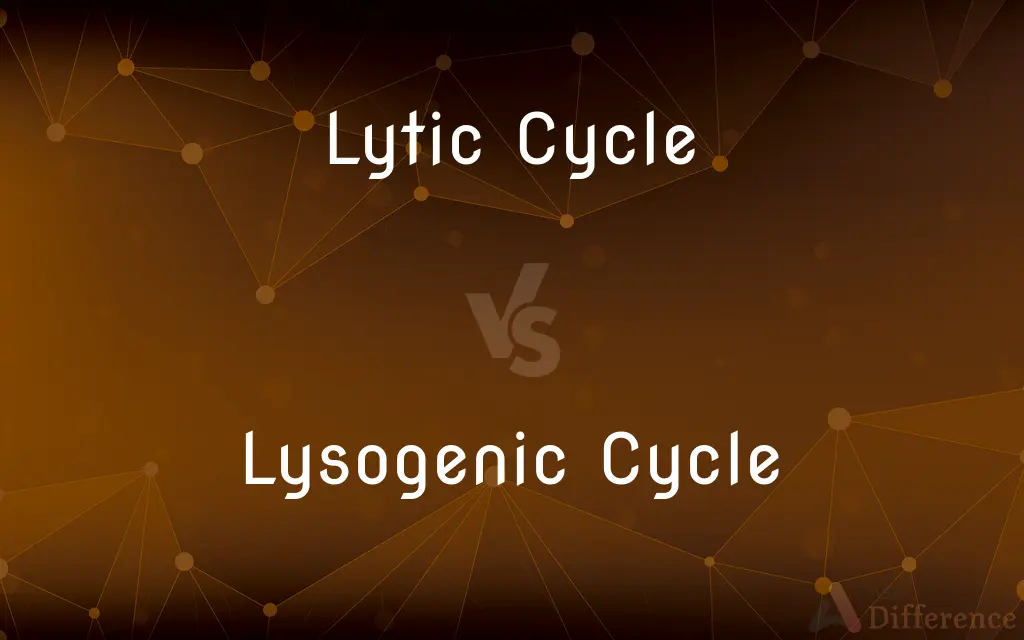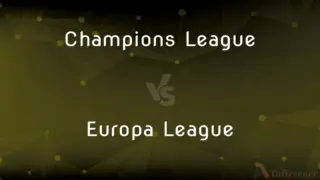Lytic Cycle vs. Lysogenic Cycle — What's the Difference?
By Tayyaba Rehman — Published on November 30, 2023
The Lytic Cycle leads to the destruction of the host cell for virus replication, while the Lysogenic Cycle integrates viral DNA into the host's genome without immediate harm.

Difference Between Lytic Cycle and Lysogenic Cycle
Table of Contents
ADVERTISEMENT
Key Differences
The Lytic Cycle is a process wherein viruses infect a host cell, subsequently leading to the cell's lysis or destruction to release new virus particles. Conversely, the Lysogenic Cycle involves the viral DNA integrating into the host genome, lying dormant and coexisting without damaging the cell.
Within the Lytic Cycle, the virus takes control of the host cell machinery to replicate its genetic material and synthesize necessary proteins. In the Lysogenic Cycle, the integrated viral DNA (prophage) can stay inactive for prolonged periods, replicating passively alongside the host cell's genome.
While the Lytic Cycle culminates in the bursting of the host cell, releasing many new viruses, the Lysogenic Cycle remains non-destructive until specific triggers induce it to revert to the lytic pathway. Consequently, the Lytic Cycle is immediately virulent, but the Lysogenic Cycle can delay virulence.
In some cases, as a part of the Lytic Cycle, the virus might introduce harmful genetic material into the host cell, leading to its immediate demise. On the other hand, during the Lysogenic Cycle, the prophage might transfer advantageous genes to the host, resulting in lysogenic conversion.
Interestingly, some viruses can switch between the Lytic and Lysogenic Cycles, making their behavior unpredictable. While the Lytic Cycle is consistently lethal, the Lysogenic Cycle offers a strategic pause, allowing viruses to survive in hosts without eliciting a strong immune response.
ADVERTISEMENT
Comparison Chart
Outcome for Host
Leads to destruction of the host cell.
Viral DNA integrates without harming the host cell.
Replication Method
Uses host machinery for immediate viral replication.
Passively replicates with host genome.
Duration
Short-term and culminates in cell lysis.
Can be dormant for extended periods.
Genetic Exchange
Might introduce lethal genes to the host.
Can transfer beneficial genes via lysogenic conversion.
Response Elicitation
Triggers immediate immune response.
Can avoid strong immune responses.
Compare with Definitions
Lytic Cycle
Ends with cell lysis to release viruses.
At the conclusion of the Lytic Cycle, numerous new viruses emerge from the destroyed host cell.
Lysogenic Cycle
Delays virulence by coexisting with the host.
Viruses in the Lysogenic Cycle can avoid detection and continue to replicate without causing disease.
Lytic Cycle
Predominantly virulent in nature.
In the Lytic Cycle, the infected cell is almost always destroyed.
Lysogenic Cycle
Potential to revert to the lytic pathway.
Certain triggers can make a virus in the Lysogenic Cycle switch to the destructive Lytic Cycle.
Lytic Cycle
Virus pathway resulting in host cell destruction.
Bacteriophages in the Lytic Cycle will cause the bacterial cell to burst and release new virions.
Lysogenic Cycle
Strategic survival without immediate harm.
The Lysogenic Cycle allows viruses to exist in hostile environments without being attacked.
Lytic Cycle
Immediate viral replication in the host.
Viruses following the Lytic Cycle quickly utilize the host's machinery to replicate.
Lysogenic Cycle
Dormant phase with viral DNA integration in host genome.
In the Lysogenic Cycle, a bacteriophage might stay inactive within a bacterial cell for years.
Lytic Cycle
Rapid and destructive viral life phase.
Many cold-causing viruses operate via the Lytic Cycle, leading to symptoms.
Lysogenic Cycle
Passive replication with the host's genetic material.
In the Lysogenic Cycle, viral DNA copies itself as the host cell divides.
Common Curiosities
Can the Lysogenic Cycle become virulent?
It can, if the dormant virus is induced to enter the Lytic Cycle.
What happens in the Lytic Cycle?
The virus infects, replicates within, and ultimately destroys the host cell.
Why might a virus choose the Lysogenic Cycle?
It allows strategic survival, potentially avoiding host immune responses or hostile environments.
Can the Lysogenic Cycle benefit the host in any way?
Occasionally, through lysogenic conversion, the host might acquire advantageous genes from the prophage.
What's the primary feature of the Lysogenic Cycle?
The viral DNA integrates into the host genome, remaining dormant without harming the cell.
Can a virus switch between the two cycles?
Yes, some viruses can transition from the Lysogenic to the Lytic Cycle under certain triggers.
How does the viral DNA behave in the Lysogenic Cycle?
It integrates into the host genome, remaining dormant and replicating passively.
Is the Lytic Cycle always harmful for the host?
Typically, yes. It leads to the destruction of the host cell.
Which cycle results in immediate viral replication?
The Lytic Cycle involves immediate replication and synthesis of viral components.
Is cell destruction a feature of the Lysogenic Cycle?
No, cell destruction is characteristic of the Lytic Cycle.
Do all viruses have both cycles?
No, some viruses exclusively follow either the Lytic or Lysogenic Cycle.
What ends the Lytic Cycle?
The lysis or bursting of the host cell, releasing new viruses.
Share Your Discovery

Previous Comparison
Champions League vs. Europa League
Next Comparison
Friends vs. Best FriendsAuthor Spotlight
Written by
Tayyaba RehmanTayyaba Rehman is a distinguished writer, currently serving as a primary contributor to askdifference.com. As a researcher in semantics and etymology, Tayyaba's passion for the complexity of languages and their distinctions has found a perfect home on the platform. Tayyaba delves into the intricacies of language, distinguishing between commonly confused words and phrases, thereby providing clarity for readers worldwide.












































